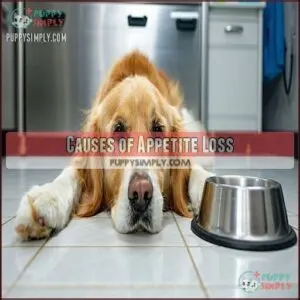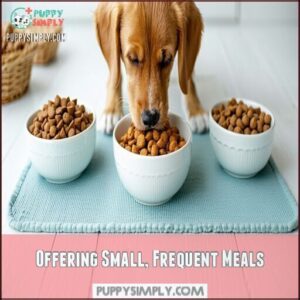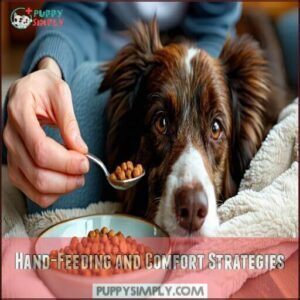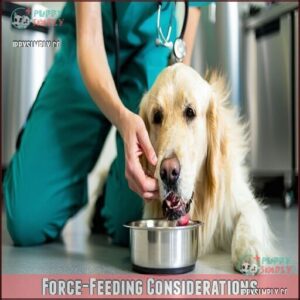This site is supported by our readers. We may earn a commission, at no cost to you, if you purchase through links.
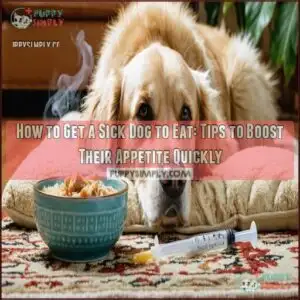 If your sick dog isn’t eating, try offering something appealing like warm chicken broth or a small amount of plain, boiled chicken and rice.
If your sick dog isn’t eating, try offering something appealing like warm chicken broth or a small amount of plain, boiled chicken and rice.
Wet food can also be more tempting since it’s softer and smells stronger. Warming the food slightly can enhance the aroma, making it more appetizing.
Hand-feeding may help if they’re feeling extra needy. You can also try baby food (without onion or garlic) or add a little bone broth to their usual meal.
Stay patient and keep portions small. If their appetite doesn’t improve or they’re losing weight, it’s time to check in with your vet.
Table Of Contents
- Key Takeaways
- Causes of Appetite Loss
- Getting Sick Dog to Eat
- Choosing Right Food
- Encouraging Water Intake
- Creating Appetizing Environment
- Feeding Techniques for Sick Dogs
- Veterinary Care and Next Steps
- Frequently Asked Questions (FAQs)
- What can a sick dog eat?
- What meat should I never feed my dog if they have dementia?
- Can a sick dog eat homemade food?
- What can I give my dog if he is sick?
- Can a dog get sick from eating too much food?
- Can a sick dog eat baby food?
- How do you get a sick dog to eat?
- What can one do if they are sick from bad food?
- Can a sick dog eat anything?
- What is the best food for a sick dog?
- Conclusion
Key Takeaways
- Try offering warm, bland foods like boiled chicken, rice, or baby food (check for safety by avoiding onion and garlic).
- Stimulate their appetite by warming wet food or adding low-sodium broth to increase aroma and flavor appeal.
- Keep meals small and frequent, and consider hand-feeding to comfort and encourage them to eat.
- Monitor for persistent symptoms and consult your vet if they refuse food for more than 48 hours.
Causes of Appetite Loss
When your dog stops eating, it’s often a sign that something’s not right with their health.
A dog’s loss of appetite usually signals something is off—act quickly to uncover the cause and support their recovery.
Common causes include illness, medication side effects, stress, or dental problems, so identifying the issue quickly is key.
Illness and Infection
Illness and infection can lower a dog’s appetite as their body focuses on recovery.
Conditions like fever, nausea, or pain make eating harder.
Watch for these signs:
- Persistent loss of appetite or weight.
- Vomiting or diarrhea tied to sickness.
- Fatigue or reluctance to move.
- Changes in mood or energy.
Consult your vet if symptoms persist. It is crucial to monitor your dog’s health and seek professional advice if you notice any persistent loss of appetite or other concerning signs.
Medication Side Effects
Sometimes, medications meant to heal can cause unintended issues like a sick dog’s appetite loss.
Appetite suppressants or nausea in dogs may stem from side effects.
Timing matters—try feeding 15 minutes after dosing.
If side effects persist, speak with your vet about dosage adjustments or alternative medications to protect the liver.
Here’s a helpful chart:
| Symptom | Possible Cause | Solution | Veterinary Role |
|---|---|---|---|
| Nausea | Medication effects | Change feeding schedule | Adjust dosage |
| Loss of Appetite | Liver impact | Try alternative meds | Prescribe alternatives |
| Vomiting | Incorrect timing | Feed later after dosing | Review medication options |
| Lethargy | Drug interactions | Monitor behavior | Recommend modifications |
Stress and Environmental Changes
Changes like travel, new pets, or disruptions to routine can leave your dog stressed and less likely to eat.
Create a calming environment to ease anxiety, especially for a sick dog. Stick to routine consistency and feed in a quiet spot.
Reducing anxiety, like minimizing loud noises, helps revive appetite. Stress can strongly impact your dog’s eating habits, so tackle triggers early to establish a quiet spot.
Dental Issues
Dental issues can impact a sick dog’s appetite, especially if eating causes pain. Common problems include dental disease or oral tumors.
If your dog won’t eat, try:
- Switching to soft food or moistening kibble.
- Offering small kibble sizes for easier chewing.
- Seeking veterinary care for pain relief.
- Avoiding hard treats.
- Monitoring for discomfort after meals.
It’s worth noting that supplement ingredients can sometimes offer supportive benefits.
Getting Sick Dog to Eat
When a dog’s appetite drops, it’s frustrating and concerning.
To encourage your dog to eat, start small and focus on what’s appealing.
Food temperature can make a big difference—warm meals release stronger aromas, making them more enticing for a sick dog.
Try utilizing palatability boosters like a splash of low-sodium chicken broth or mixing wet and dry food to explore different texture preferences.
Stick to a regular feeding schedule, offering small meals throughout the day.
Hand-feeding might also comfort your dog and promote eating.
If your dog won’t eat, consider safe appetite stimulants, but only after consulting your vet.
Be patient, try various gentle methods, and keep water intake steady while observing how your canine responds to these adjustments.
If symptoms persist after 48 hours, it’s advisable to think about veterinary treatment options.
Be patient, try various gentle methods, and keep water intake steady while observing how your canine responds to these adjustments, including maintaining a regular feeding schedule and considering appetite stimulants for support.
Choosing Right Food
Choosing the right food can make all the difference when your dog isn’t feeling well.
Opt for options that are easy to digest, nutritious, and appealing to encourage them to eat, as this can be a complete solution.
Wet Food Options
Wet food can tempt a sick dog’s appetite with its palatability and nutritional benefits.
Store leftovers in airtight containers to keep them fresh.
Many pet owners find palatable wet food helpful for picky eaters.
Consider these options:
- Commercial brands: Look for highly palatable dog food with easy-to-digest ingredients.
- Homemade options: Try unseasoned chicken mixed with water or broth.
- Moist food: Choose cans or pouches designed specifically to entice a sick dog.
Baby Food for Dogs
If wet food doesn’t entice your sick dog, baby food can work wonders.
Choose meat-based, Stage II options without onion, garlic, or xylitol for ingredient safety. Its soft texture eases feeding, especially when handfeeding a dog with appetite loss.
You can even easily find dog baby food online.
Follow feeding guidelines, offering small portions, and always check labels to confirm proper nutritional value for your dog.
Bone Broth Benefits
If baby food didn’t work, consider bone broth to encourage your sick dog to eat. It’s a palatability boost and provides hydration, making mealtime more appealing.
Plus, bone broth supports joint health, gut health, and immune support. For convenient options, consider pre-made bone broths.
- Simmer bones for hours for nutrient-rich broth.
- Serve 1–2 tablespoons daily.
- Avoid store-bought broths with added sodium, to ensure a healthy and natural diet.
Chicken Broth for Dogs
Adding chicken broth to your dog’s meals is a great way to tempt a sick dog’s appetite.
Choose low-sodium options or make a homemade broth by simmering chicken bones and meat.
Broth benefits include hydration and added nutrients.
If your dog’s not eating, warm the broth to enhance its aroma.
Bone broth or broth alternatives also work well, providing a useful alternative.
Encouraging Water Intake
Keeping your sick dog hydrated is just as important as getting them to eat.
Simple tricks like adding flavor to water or offering ice cubes can make drinking more appealing and help prevent dehydration.
Importance of Hydration
Keeping your dog hydrated is as important as encouraging them to eat.
Recognizing dehydration helps you act quickly. Try adding water to their meals or spoon-feeding broth.
Here’s how to check hydration:
- Look for dry gums or lethargy.
- Gently lift skin at the neck; slow return signals dehydration.
- Offer broth benefits, like nutrients and electrolytes, without causing aspiration.
Flavored Water and Electrolyte Solutions
If your dog isn’t drinking enough, flavored water or electrolyte solutions like unflavored Pedialyte can help.
DIY electrolytes or diluted chicken broth work well for hydration and appeal.
Understand your dog’s flavor preferences—some enjoy beef bouillon while others like bone broth.
For severe dehydration in dogs, syringe hydration might be necessary.
Watch for dog dehydration symptoms and consult your vet.
Monitoring Hydration Levels
Hydration is essential for recovery.
Keeping your dog hydrated speeds up recovery and boosts their overall well-being—never underestimate the power of fresh water.
Check your dog’s gums—healthy ones are pink, slick, and wet. Test skin turgor by gently pulling skin; if it snaps back, hydration levels are fine.
Watch for dehydration symptoms like lethargy, dry gums, or loss of elasticity.
Provide clean water access, and consider electrolyte solutions. Persistent dog dehydration needs immediate veterinary care.
Creating Appetizing Environment
You can make mealtime more appealing by focusing on your dog’s environment and the way food is prepared.
Simple adjustments, like warming their food or reducing distractions, can encourage them to eat, which is a simple yet effective approach to improve their dining experience.
Warming and Enhancing Wet Food
To entice a sick dog, try warming dog food safely in the microwave or a low oven.
This boosts aroma enhancement, increases palatability, and improves digestibility factors, helping stimulate appetite.
Gently heated wet food releases flavors, catering to dog food preferences and reducing stress during mealtime.
Monitor the temperature; lukewarm food avoids burns but still delivers a nutritional impact for sick dogs, which can be crucial for their recovery and overall well-being.
Homemade Bland Diet Recipes
Preparing homemade dog food may help when your pup’s appetite drops. A bland diet for dogs, like chicken and rice, is easy to digest and soothing.
Stick to simple recipes with balanced portions.
- Boil 75% white rice and 25% chicken or ground beef.
- Avoid seasoning and fatty cuts.
- Serve room-temperature portions.
- Refrigerate leftovers for up to 72 hours, which helps maintain a healthy environment.
Nutrient-Rich Broths and Liquids
After homemade bland meals, consider nutrient-packed broths like bone broth or dog chicken broth.
Broth benefits include hydration, essential minerals, and increased broth palatability for picky eaters.
Broth recipes can incorporate low-sodium options or electrolyte solutions.
Syringe feeding a dog small amounts can help manage dehydration in dogs.
Use broth alternatives like diluted vegetable stock for variety and appeal.
Feeding Techniques for Sick Dogs
When your dog isn’t eating well, adjusting how you offer their food can make a big difference.
Using small, frequent meals or even hand-feeding can help them feel more comfortable and encouraged to eat.
Offering Small, Frequent Meals
Small, frequent meals work wonders for a sick dog’s appetite.
They prevent overeating, support the digestive system, and aid nutrient absorption.
Offer just a spoonful or two at a time to avoid overwhelming them.
Rotating flavors adds palatability variety, keeping interest alive.
This feeding method helps with energy maintenance and gives you more chances to encourage the dog to eat.
Hand-Feeding and Comfort Strategies
Hand-feeding a dog can reduce anxiety and build trust, making eating less stressful. Use gentle encouragement and stay calm to create a positive experience.
Hold small portions close to their nose to entice them. A stronger aroma from wet food can be more appealing to sick dogs. Wet food options may help stimulate their appetite.
- Feed with clean hands or a spoon for comfort.
- Sit at their level to ease nervousness.
- Praise softly to encourage eating efforts, which can help build trust.
Force-Feeding Considerations
If your dog won’t eat, avoid force-feeding unless absolutely necessary; it risks aspiration, owner stress, and ethical concerns.
Instead, try syringe feeding under veterinary guidance or consider tube feeding for critical cases.
Always consult your vet for the safest options.
| Feeding Methods | Pros |
|---|---|
| Syringe Feeding | Controlled, temporary fix |
| Tube Feeding | Sustains critical patients |
Veterinary Care and Next Steps
If your dog isn’t eating or shows signs of illness, it’s time to consult a veterinarian.
They can identify the underlying cause and recommend treatments, ensuring your pet gets the care they need.
When to Seek Veterinary Attention
If your dog won’t eat or shows alarming symptoms, contact your vet.
Warning signs include:
- Persistent vomiting or diarrhea lasting over 24 hours.
- Sudden lethargy or major behavior changes.
- Blood in stool, weight loss, or dehydration signs.
- Refusal to drink, worsening your dog’s illness.
Don’t wait—quick veterinary consultation guarantees proper care and diagnosis for sick dog appetite recovery.
Sudden irritability can also indicate illness, so monitor your pet and seek help if you notice significant behavior changes.
Prescription Diets and Medication
Vet-recommended food, like prescription diets, can address illness-related appetite loss.
Designed for specific needs, these diets improve nutrition and digestion. If your dog’s medication side effects suppress hunger, consult your vet about timing adjustments or appetite stimulants.
For severe cases, tube feeding or alternative options may help. Prioritize diet palatability to encourage eating and keep your dog comfortable during recovery.
Ongoing Care and Monitoring
Regular dog health monitoring is essential while they recover.
Track weight, symptoms, and behavioral changes daily.
Adjust the diet based on their needs, and watch for medication effects.
If their condition worsens, consult a vet promptly.
- Keep a symptom log to share during checkups.
- Monitor their weight weekly.
- Discuss any dietary adjustments with your vet.
- Watch for treatment side effects.
- Schedule follow-up veterinary examinations.
Frequently Asked Questions (FAQs)
What can a sick dog eat?
Imagine giving your dog a comforting bowl of warmth—try bland, unseasoned chicken with rice, bone broth, or plain pumpkin.
These gentle, easy-to-digest foods soothe the stomach and encourage eating without overwhelming their system, which can be especially helpful when considering comforting options.
What meat should I never feed my dog if they have dementia?
Avoid fatty or processed meats like bacon, sausage, and ham, as they can worsen dementia symptoms due to high fat and sodium content.
Stick to lean meats like boiled chicken or turkey for balanced nutrition.
Can a sick dog eat homemade food?
Did you know dogs can survive 7 days without food?
If your sick pup resists eating, homemade options like boiled chicken, rice, or plain pumpkin are gentle and nutritious.
Always consult your vet for dietary advice.
What can I give my dog if he is sick?
You can offer bland foods like boiled chicken with rice, unseasoned pumpkin, or bone broth.
Try moistening dry kibble with broth, serving small portions, or slightly warming wet food to enhance aroma and appeal.
Can a dog get sick from eating too much food?
Yes, overeating can make dogs sick.
They may experience vomiting, diarrhea, bloating, or even a life-threatening condition called bloat.
Feed appropriate portions, and if symptoms appear, consult your vet promptly for guidance and treatment to prevent serious conditions like bloating.
Can a sick dog eat baby food?
When your dog’s appetite wanes, baby food can be a gentle option.
Choose meat-based varieties without onion, garlic, or harmful seasonings.
Its smooth texture and mild flavor might tempt even the pickiest eater.
How do you get a sick dog to eat?
Try warming up soft or wet food to enhance its aroma and flavor.
Hand-feed them small portions, or mix a little chicken broth to make the food more appealing.
Always make certain they’re staying hydrated.
What can one do if they are sick from bad food?
If you’re feeling sick from bad food, stay hydrated with water or electrolyte drinks.
Rest your stomach by eating bland foods like bananas, rice, or toast.
Seek medical help if symptoms worsen or persist.
Can a sick dog eat anything?
When your dog’s under the weather, think "gentle and tempting."
Offer warm, unseasoned foods like boiled chicken or rice, try wet food or low-sodium broth.
Always consult your vet if they won’t eat, this is a critical step to ensure your dog receives proper care.
What is the best food for a sick dog?
Offer bland, easily digestible foods like boiled chicken, plain rice, or unseasoned canned pumpkin.
Wet food or warm broth can tempt picky eaters.
Always consult your vet before introducing new foods to their diet.
Conclusion
Supporting your dog when they’re feeling unwell can be challenging, but getting a sick dog to eat is key to helping them recover.
By trying warm, appetizing options like chicken broth, wet food, or baby food, you can encourage their appetite gently.
Keep mealtimes stress-free, offer small portions, and make certain they stay hydrated.
If their appetite doesn’t improve, consult your vet for guidance.
Your care and patience make all the difference in their healing process.

